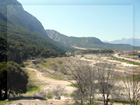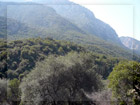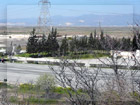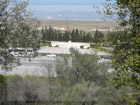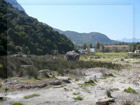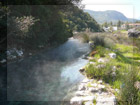
 |
| MAIN |
| Introduction |
| Greek Preparations |
| Armies |
| Battlefield |
| Battle |
| Aftermath |
| Date |
| Monuments |
| COMPLEMENTARY |
| Thermopylae |
| Leonidas I |
| Xerxes I |
| Sparta |
| Thespiae |
| Molon Labe |
| Thermopylae |
||||||
|
Thermopylae ("hot gateway") is a location in Greece where a narrow coastal passage existed in antiquity. It derives its name from several natural hot water springs. It is primarily known for the Battle of Thermopylae in 480 BC in which an overmatched Greek force held off advancing Persians under Xerxes, and the term since has been used to reference heroic resistance against a more powerful enemy. Characteristics The location is a near-mandatory passage in the main north-south road between Locris and Thessaly in Greece, with excellent defensive terrain, and for this reason it was the site of several battles. In the time of Leonidas in 481 BC, the pass was a narrow track (probably about 14 metres/yards wide) under the cliff. In modern times, the deposits of the Spercheios River have widened it to a breadth of 2 to 5 kilometers (1 to 3 miles). The short part of the path has thus migrated to the East so the battle of Sprercheios in 10th century between the forces of Samuil of Bulgaria and the Byzantine general Nikephoros Ouranos took place more to the north, while the 1821 Greek revolution Battle of Alamana and the Hani of Gravia while very close did not take place on Thermopylae.
A main highway now splits the pass, with a modern-day monument of Leonidas on the east side of the highway. It is directly across the road from the hill where Simonides' epitaph is engraved in stone at the top.
The hot springs from which the pass derived its name still exist close to the foot of the hill.
Battles Greeks and Persians Thermopylae is primarily known for the battle that took place there in 480 BC, in which an overmatched combined Greek force of approximately 4,000 held off advancing Persians under Xerxes, and the term since has been used to reference heroic resistance against a more powerful enemy. The combined Greek force of 4,000 included 300 Spartans, a number of Greek slaves, and allies from Arcadia, Corinth, Thespiae and Thebes. Though the Persians were many in number, and their manpower clearly exceeded that of the Greeks, estimates of their actual strength vary widely, from an army as large as 2 million to only 200,000. Greeks and Gauls In 279 BC a Gallic army lead by a Brennus (not to be confused with the Brennus who sacked Rome in 387 BC) was checked for several months by a Greek army under the Athenian Calippus. Roman-Seleucid wars In 191 BC Antiochus III the Great of Syria attempted in vain to hold the pass against the Romans under Manius Acilius Glabrio. Less famous is the confrontation of 353 BC/352 BC during the Third Sacred War when 5,000 Athenian hoplites and 400 horsemen denied passage to the forces of Philip II of Macedon and the battle of 267 when the Heruli defeated the Greek force that tried to stop them. Greek War of Independence In 1821, a force of Greek fighters led by Athanasios Diakos made a stand near the pass to stop a force of 8,000 Turks from marching down from Thessaly to put down revolts in Roumeli and the Peloponnese. Diakos, after making a last stand at the bridge of Alamana with 48 of his men, was captured and roasted alive after refusing conversion to Islam. World War II In 1941 during World War II the ANZAC forces delayed the invading German forces in the area enough to allow the evacuation of the British expeditionary force to Crete. This conflict also became known as the Battle of Thermopylae, probably because the two sides were aware only of the name of this site in the entire Phthiotis region. Such was the fame of Thermopylae that the sabotage of the Gorgopotamos bridge in 1942 was referred in German documents of the era as "the recent sabotage near Thermopylae".
Permission is granted to copy, distribute and/or modify this article under the terms of the GNU Free Documentation License, Version 1.2 or any later version published by the Free Software Foundation.
(What does it mean?)
The text is based on material from the Wikipedia article "Battle of Thermopylae". Modifications, additions to the Wikipedia text and all the photos by the website author. |
